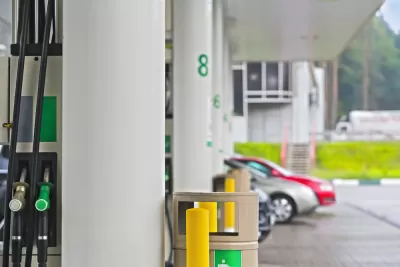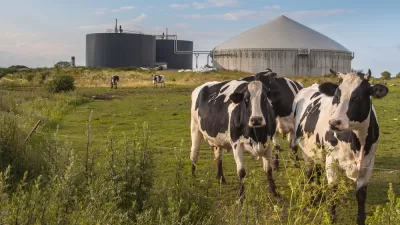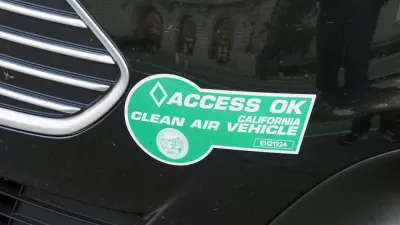California regulators have found that transportation emissions are the most difficult to reduce, unlike those from electricity generation. The state just took a major step by approving significant changes to its Low Carbon Fuel Standard program.

Sustainability experts often use the metaphor of a three-legged stool to describe how to reduce carbon emissions from transportation:
- Improving vehicle technology and efficiency
- Reducing carbon intensity of fuels
- Reducing vehicle-miles-traveled, also called "sustainable land-use."
However, only two states have regulatory programs to tackle the middle leg: California and Oregon. California just took a huge step to strengthen that regulation, allowing for greater investment in the first leg.
At its meeting on Sept. 27- 28, the California Air Resources Board (CARB) approved amendments to extend the Low Carbon Fuels Standard (LCFS) program by 10 years, consistent with the passage of Senate Bill 32 in 2016. SB 32 called for reducing greenhouse gas emissions 40 percent below 1990 levels by 2030, and required a 20 percent reduction in the carbon intensity of transportation fuels by 2030.
The program began under former governor Arnold Schwarzenegger, and was enacted by regulation in 2009 made possible by his signature on the Global Warming Solutions Act of 2006 (Assembly Bill 32) and his signing of Executive Order S-01-07 [pdf]. The goal was to reduce the carbon intensity of transportation fuels by 10 percent by 2020.
Biofuels substituting for fossil fuels
The program has successfully promoted the use of biofuels for transportation since 2011.
"These low-carbon alternative fuels, consisting mostly of biodiesel, renewable diesel, and ethanol, avoided 14 million metric tons of carbon dioxide from entering the atmosphere, compared to what would have happened if conventional fossil fuels had been used," notes a July post marking the achievement of AB 32's goal to reduce greenhouse gas emissions to 1990 levels by 2020.
"Last year, the LCFS resulted in more than two billion gallons of petroleum and natural gas being replaced with cleaner, renewable transportation fuels," according to CARB.
Another amendment the board approved allows for the addition of credits for alternative aviation fuels which "makes the program more flexible and adds a major source of potential greenhouse gas reductions," said Board Chair Mary D. Nichols.
Incentives for zero emission vehicles and infrastructure
The program also encourages fuel providers to reduce carbon intensity through its credit-trading system, generated by producers of cleaner fuels which can be sold to refineries and fuel importers whose products will not meet the program's declining benchmark for carbon intensity. See the January 2018 fact sheet prepared by the Union of Concerned Scientists (UCS), "California’s Clean Fuel Standard Boosts the Electric Vehicle Market [pdf]," for a better understanding of how the process works.
The amendments approved on Sept. 28 "incentivize development of additional zero emission vehicle infrastructure and the sale of electric and hydrogen vehicles, building on utilities ability to collect LCFS credits based on charging [see aforementioned UCS paper], and adding provisions to jump start infrastructure installation through credits generated based on the expected capacity of fast charging and hydrogen refueling stations," according to CARB.
Increased rebates for zero emission vehicles (ZEVs)
John Lippert of Bloomberg News reported two days before the meeting that CARB was considering increasing the state rebates for ZEVs by $2,000.
The state is able to consider an increase in its electric-car subsidy partly because revenue is becoming available as companies buy more credits to comply with the state’s low carbon fuel standard, said Dan Sperling, a UC Davis transportation professor who is also a member of the Air Resources Board.
The state's current $2,500 electric-car rebate comes from a different source: the purchase of credits to comply with the state's cap-and-trade program for reducing carbon dioxide emissions
Betsy Lillian, editor of Next-Gen Transportation (NGT) News, reports on the amendments to the LCFS program in the source article, and two other noteworthy action items the board approved:
- "CARB announced [on Sept 26] up to $205 million in grants for projects designed to accelerate the adoption of clean freight technologies and reduce air pollution caused by the movement of goods throughout the state. [See related Oct. 4 post: "Volvo to Sell All-Electric Heavy Trucks in North America in 2020."]
- CARB took action to ensure that Californians will be able to buy and drive cars that meet current clean car standards, even if the U.S. Environmental Protection Agency (EPA) rolls back federal standards.
"[This] vote by the board ensures that California and 12 other states will not fall victim to the Trump administration's rollback of vehicle standards should its proposal be finalized,” stated Nichols.
Additional information:
- Green Car Congress, Sept. 28: "CARB extends Low Carbon Fuel Standard by 10 years, doubles the intensity reduction target to 20%."
- CARB presentation at Sept. 27 public hearing: "2018 Proposed Amendments to the Low Carbon Fuel Standard Regulation and to the Regulation on Commercialization of Alternative Diesel Fuels" [pdf].
Hat tip to Melanie Curry, Streetsblog California: Today's Headlines.
FULL STORY: California Takes Trio of Clean Transportation Actions

Study: Maui’s Plan to Convert Vacation Rentals to Long-Term Housing Could Cause Nearly $1 Billion Economic Loss
The plan would reduce visitor accommodation by 25,% resulting in 1,900 jobs lost.

Alabama: Trump Terminates Settlements for Black Communities Harmed By Raw Sewage
Trump deemed the landmark civil rights agreement “illegal DEI and environmental justice policy.”

Why Should We Subsidize Public Transportation?
Many public transit agencies face financial stress due to rising costs, declining fare revenue, and declining subsidies. Transit advocates must provide a strong business case for increasing public transit funding.

Paris Bike Boom Leads to Steep Drop in Air Pollution
The French city’s air quality has improved dramatically in the past 20 years, coinciding with a growth in cycling.

Why Housing Costs More to Build in California Than in Texas
Hard costs like labor and materials combined with ‘soft’ costs such as permitting make building in the San Francisco Bay Area almost three times as costly as in Texas cities.

San Diego County Sees a Rise in Urban Coyotes
San Diego County experiences a rise in urban coyotes, as sightings become prevalent throughout its urban neighbourhoods and surrounding areas.
Urban Design for Planners 1: Software Tools
This six-course series explores essential urban design concepts using open source software and equips planners with the tools they need to participate fully in the urban design process.
Planning for Universal Design
Learn the tools for implementing Universal Design in planning regulations.
Smith Gee Studio
Alamo Area Metropolitan Planning Organization
City of Santa Clarita
Institute for Housing and Urban Development Studies (IHS)
City of Grandview
Harvard GSD Executive Education
Toledo-Lucas County Plan Commissions
Salt Lake City
NYU Wagner Graduate School of Public Service





























